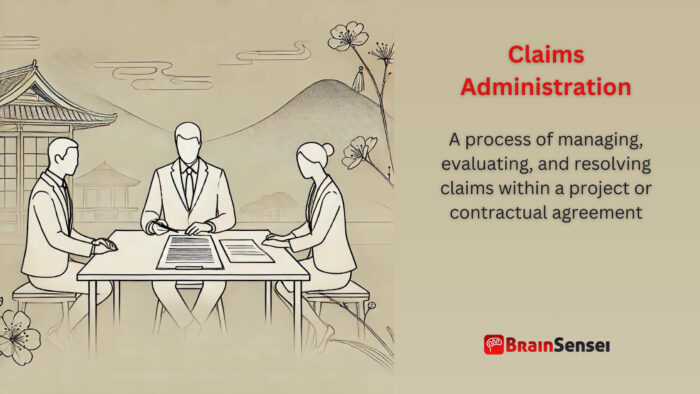
Claims Administration
What is Claims Administration?
Claims administration is the process of managing, evaluating, and resolving claims within a project or contractual agreement. It also involves assessing disputes, ensuring compliance with contract terms, and facilitating negotiations between involved parties. This function is crucial in industries with high contractual obligations and financial risks, such as construction, insurance, and healthcare.
Key Takeaways
- Claims administration efficiently and fairly manages contractual disputes.
- It involves claim documentation, evaluation, and resolution.
- Effective claims administration minimizes financial and legal risks.
- It applies across industries such as construction, insurance, and healthcare.
- Strong claims management helps maintain project timelines and relationships.
Understanding Claims Administration
How It Works
Claims administration follows a structured process to manage claims effectively. Key steps include:
- Claim Identification: Recognizing a potential claim due to deviations from agreed terms, unforeseen events, or disputes.
- Claim Documentation: Collecting relevant information, such as contracts, invoices, correspondence, and reports.
- Claim Evaluation: Assessing the claim’s validity based on contractual obligations and legal principles.
- Claim Negotiation: Engaging in discussions to resolve disputes through mutual agreement.
- Claim Resolution: Settling the claim via compensation, contract adjustments, or legal arbitration if necessary.
Notes
- Proper Documentation: Incomplete or unclear documentation can weaken a claim.
- Legal Compliance: Ensuring claims adhere to local laws and regulations.
- Timely Processing: Delays can escalate disputes and financial risks.
- Negotiation Skills: Effective communication and negotiation can prevent litigation.
Related Terms
- Contract Management: Overseeing contracts to ensure compliance and minimize disputes.
- Dispute Resolution: Claimants and respondents use mediation and arbitration to settle claims.
- Risk Management: Identifying and mitigating potential risks that may lead to claims.
- Change Order Management: Managing project modifications that may trigger claims.
- Litigation Management: Handling legal proceedings when claims escalate to court.
Examples of Claims Administration in Different Industries
Claims Administration in the Construction Industry
In the construction industry, claims administration is critical in handling disputes related to contract changes, delays, and unforeseen site conditions. For example, a contractor working on a commercial building project may encounter unexpected underground utilities not disclosed in the original site survey. This discovery leads to delays and additional costs, which the contractor files a claim against the project owner to recover.
In this case, claims administration ensures that all relevant documents—such as the initial contract, change orders, and communications—are collected and analyzed. The claims administrator then works with both parties to evaluate the claim’s merit and negotiate a resolution. The parties involved may adjust the contract and award financial compensation if the claim is valid. Such disputes could lead to project stoppages, legal battles, and strained business relationships without an effective claims administration process.
Another common construction-related claim arises when subcontractors are not paid on time due to disputes between the general contractor and the project owner. Claims administration ensures subcontractors provide proper documentation, such as invoices and proof of work completion, to support their claims. Effective management of these claims helps keep projects on schedule and prevents costly litigation.
Claims Administration in the Healthcare Industry
Claims administration is crucial in the healthcare industry, particularly in medical insurance claims processing. A typical scenario involves a patient undergoing a medical procedure and later having their insurance provider deny it due to insufficient pre-authorization. The patient or healthcare provider then files a claim to appeal the denial.
In such cases, claims administrators review the patient’s policy, medical records, and prior authorizations to determine whether the claim should be approved. They work closely with insurance adjusters and medical professionals to ensure compliance with policy terms and legal regulations. If the claim is legitimate, it is processed, and the patient receives the necessary financial reimbursement.
Fraudulent claims are another challenge in healthcare claims administration. For instance, a provider may submit duplicate claims for the same procedure, leading to potential financial losses for insurance companies. Claims administrators use data analytics and fraud detection tools to identify discrepancies, investigate suspicious activities, and prevent fraudulent payments. Proper claims administration efficiently processes legitimate claims and mitigates fraud.
Claims Administration in IT and Software Development
Disputes over project deliverables, intellectual property rights, or payment issues in IT and software development often necessitate claims administration. For example, a client hires a software development firm to build a custom application within a specific timeframe. However, the client later claims the software does not meet the agreed-upon requirements and refuses to make the final payment.
Claims administrators assess the project contract, software specifications, and communication records to determine the claim’s validity. If the client’s concerns are justified, the software development firm may need to make additional modifications without additional charges. Conversely, if the claim is invalid, the firm may take legal action to recover unpaid fees.
Another common scenario involves licensing disputes, in which a company claims a software vendor breached a licensing agreement by exceeding usage limits. In such cases, claims administration reviews license agreements, usage reports, and contract terms to determine whether a breach has occurred. Handling these claims helps maintain business integrity and reduce potential legal disputes.
Use Cases of Claims Administration
United States (Construction Dispute)
A real estate developer in Texas initiated a large-scale residential project with a general contractor. Midway through the project, unexpected soil conditions required additional foundation work, significantly increasing costs. The contractor submitted a claim for additional compensation, citing unforeseen site conditions.
The claims administrator reviewed soil test reports, contractual terms, and change order procedures. Through structured negotiations, the administrator reached a compromise: The developer agreed to a partial compensation increase while the contractor optimized resource allocation to mitigate costs. Claims administration ensured transparency, efficiency, and project continuity while avoiding costly litigation.
France (Infrastructure Project)
A major railway expansion project in France faced delays due to supply chain disruptions. The subcontractors involved in track laying filed claims for cost overruns caused by inflation and material shortages. The public infrastructure authority responsible for the project contested these claims, arguing that the contract did not allow for price adjustments.
The claims administrator conducted a comprehensive contract analysis, referencing clauses related to force majeure and escalation provisions. After mediation sessions, the parties agreed on a structured compensation framework and partially reimbursed suppliers based on verified material cost increases. Handling claims effectively kept the project on track with minimal legal entanglements and financial burdens.
Saudi Arabia (IT Services Agreement)
A Saudi Arabian banking institution hired a software development company to build a custom fintech solution. As the project progressed, the bank requested additional security features beyond the initial contract scope. The software company filed a claim for extra development costs, while the bank argued that the original agreement implied these enhancements.
The claims administrator facilitated structured negotiations by analyzing contract language, industry standards, and previous project correspondence. The bank and software company resolved: the bank covered partial costs, and the software company absorbed specific enhancements as goodwill to maintain the long-term business relationship. Effective claims administration ensured minimal disruptions and a sustainable client-vendor partnership.
Best Practices in Claims Administration
Effective claims administration requires a structured approach and adherence to industry best practices. Below are some essential strategies for optimizing claims management:
Maintain Clear Contracts
Well-defined contract terms minimize ambiguity and reduce the likelihood of disputes.
Use Claims Management Software
Automated tools enhance accuracy, streamline documentation, and speed up resolution times.
Train Employees on Claims Handling
A well-trained workforce can prevent unnecessary escalations and improve efficiency.
Implement Timely Dispute Resolution Strategies
Promptly addressing claims reduces financial and legal risks.
Conduct Regular Audits
Periodic claim reviews identify patterns of disputes and areas for improvement.
Foster Transparent Communication
Open and honest dialogue between all parties involved reduces misunderstandings.
Develop Contingency Plans
Being prepared for potential disputes can help organizations navigate challenges more effectively.
Engage Legal Experts When Necessary
Seeking legal counsel can help in complex claims requiring arbitration or litigation.
Document Everything
Maintaining thorough records of claims, contracts, and negotiations is essential for validation and compliance.
Monitor Industry Trends and Regulations
Staying informed about laws and best practices changes ensures continued compliance and efficiency.
An intense claims administration process mitigates risks and fosters positive business relationships and long-term success.
Claims Administration: Common Mistakes and Issues
Poor Documentation
One of the most common mistakes in claims administration is inadequate documentation. Without proper records, validating claims becomes difficult, leading to disputes and legal vulnerabilities. Documentation should include contracts, correspondence, invoices, and other supporting materials to substantiate claims.
Delaying the recognition and resolution of potential claims can escalate disputes, making them more complex and costly. Regular risk assessments and proactive communication can help identify and address issues before they become significant claims.
Lack of Communication
Miscommunication between parties involved in a claim often results in misunderstandings and delays. Establishing clear communication channels and maintaining transparency in the claims process help avoid unnecessary conflicts.
Failure to Follow Procedures
Non-compliance with claims administration procedures can invalidate claims and lead to financial losses. Organizations should establish clear policies and train employees to ensure compliance with standard operating procedures.
Inconsistent Claims Evaluation
Applying inconsistent criteria to claim evaluations can lead to unfair or biased decisions, resulting in dissatisfaction and legal challenges. Standardizing claim assessment processes helps ensure fairness and transparency in claim resolutions.
Addressing these common mistakes can help organizations improve the efficiency of their claims administration processes and mitigate financial and legal risks.
Claims Administration: Frequently Asked Questions (FAQs)
What industries use claims administration?
Claims administration is prevalent in construction, insurance, healthcare, and legal sectors, where contract disputes and financial claims are common.
How does claims administration help reduce legal risks?
It ensures all claims are properly documented, evaluated, and resolved through negotiation or legal processes, reducing exposure to litigation.
What is the role of a claims administrator?
A claims administrator oversees claim processing, ensuring accuracy, compliance, and fair resolutions between parties.
How can businesses improve their claims administration process?
Claim management software, maintaining clear documentation, and training staff in claims resolution techniques enhance efficiency.
What happens if a claim is disputed?
Disputed claims undergo further review, negotiation, or legal resolution through mediation, arbitration, or court proceedings.
Additional Resources
- Construction Claims and Responses: Effective Writing and Presentation
- Improving project management through effective contract and claim management
Preparing for a PMI certification?
- Exam Prep Courses: PMP®, CAPM®, and PMI-ACP®
- Exam Simulators: PMP®, CAPM®, PMI-ACP®, PMI-PBA®, PMI-RMP®, PMI-SP®, PgMP®, and PfMP®
- Professional Development Units (PDUs): 15, 30, and 60 PDU Bundles



